-
PDF
- Split View
-
Views
-
Cite
Cite
Martin Hendry, Graham Woan, Gravitational astrophysics, Astronomy & Geophysics, Volume 48, Issue 1, February 2007, Pages 1.10–1.17, https://doi.org/10.1111/j.1468-4004.2007.48110.x
Close - Share Icon Share
Observational astrophysics is often presented as the ultimate remote-sensing problem. There is no possibility of travelling to the majority of targets to interact with them and carry out experiments. Furthermore, many of our most closely studied targets have long since entirely ceased to exist, and can be studied only by reconstruction via their radiation fields. The tools at our disposal, though powerful, are limited in scope. Indeed, the vast majority of what we know about the universe comes from studying a single measure: the second moment (variance) of the electric component of the electromagnetic radiation field. This single statistic has delivered nearly all the imaging, spectroscopy and multiwavelength astrophysics that shapes our current view of the universe. We give it many names, such as apparent magnitude, fringe visibility and photon counts, but essentially we are studying a statistic of the ensemble electric field from many independent charged particles in a remote environment. Astrophysics based on the electromagnetic field will always be so. Although large-scale coherent electromagnetic processes do exist (in, for example, astrophysical masers and pulsar radio emission) the majority of what we see is the result of the random motions of charged particles in similar environments and the nature of the electromagnetic interaction means that small-scale emission mechanisms dominate. The field itself is also random but can be characterized by its statistics, themselves dependent on the distribution of environmental conditions in the source. It is from these statistics, rather than the field itself, that we learn about the environment.
This may seem a perverse way of describing observational astrophysics, but it highlights limitations of our techniques and gives a flavour of what we may be missing. Forms of non-electromagnetic astronomy exist, notably based on cosmic-ray and neutrino-particle counts, but the last (as far as we know) truly great challenge in observational astrophysics is to measure the gravitational field from distant sources.
This is not a new topic. The first direct gravitational astronomy was carried out in 1797–98 by Henry Cavendish following his determination of the gravitational constant G and measurement of the mass of the Earth via its gravitational pull. Admittedly the Earth is something of a soft target for gravitational astronomy, but Cavendish's exquisitely sensitive experiment set the tone for what was to come. Unfortunately, direct measurement of the static gravitational field from distant sources is not a practical proposition; the detection of gravitational waves, generated by accelerating masses in a manner similar to the way electromagnetic waves are generated by accelerating charges, is practical. What is more, all mass has the same gravitational sign and tends to stick together to generate large coherent bulk motions, for example in binary stellar orbits (figure 1). These in turn generate powerful, coherent gravitational waves that directly reflect the motion. Electromagnetic radiation is usually generated by small-scale motions of charged particles, but powerful gravitational radiation can arise on stellar scales and with correspondingly long wavelengths, where the interstellar medium is electromagnetically opaque.
An artist's impression of a compact binary white dwarf system. Gravitational waves, generated by the orbital motion, radiate energy out of the system. (NASA/Dana Berry, Sky Worlds Digital)
Unique view
Gravitational waves therefore give us, among other things, a unique and direct view of the bulk motions of mass. There is no longer a need to work with a statistic of the field as one does in electromagnetic astronomy because the oscillating field itself traces the motion of interest. This has one immediate consequence: the field strength falls off as 1/r at distance r from the source, whereas the second moment of the field (or power) falls off as 1/r2. This means that the reach of this type of gravitational astronomy – that is, the maximum distance at which one can see a particular source – is simply proportional to the instrument sensitivity. For a particular class of source therefore, a factor of 10 improvement in sensitivity opens up 1000 times the volume of space to observation. In addition, normal matter has a very low gravitational opacity; the universe is largely transparent to gravitational waves. For example, although the cosmic microwave background radiation decoupled from matter about 380 000 years after the Big Bang, the cosmic gravitational background radiation (CGBR) probably did so after only about 10-35 s. CGBR observations would therefore see further back in time and reveal the mass distribution in the universe at this earliest instant, though their detection will be a significant challenge.
Given its clear attractions, why is gravitational astronomy not a standard technique in the astrophysicist's observational toolbox? The answer is a surprising one and has little to do with the flux density of gravitational waves that bathe us. This may come as a surprise to anyone familiar with the technical tour de force and phenomenal strain sensitivities achieved by current gravitational wave detectors. For example, at frequencies between 50 Hz and 1 kHz the LIGO observatories measure, in a second, an oscillating fractional change of separation (strain) of two masses over a distance of several kilometres, to better than one part in 1022. That's roughly equivalent to measuring the change in distance to the nearest star to one tenth of the width of a human hair – a stunning performance by any standards. It is instructive to express the same sensitivity in terms of the power flux from the source. A monochromatic gravitational wave of rms strain h and frequency f has a power flux of which, for h= 10-22, is about 1 mW m-2 at 280 Hz (Schutz 1985). To put this into perspective, it is equivalent to the signal from a mobile phone at a distance of 15 m, or a magnitude –11 star (the full Moon is magnitude –12.7). So why are our best telescopes apparently so insensitive? The reason is that, to use a mechanical analogy, spacetime is very stiff. A signal that carries a lot of power at these frequencies generates only a small strain. This would not matter if we could construct detectors that were similarly stiff so that we could measure the large induced stress, but the current generation of detectors are purely strain-based and therefore need to work hard to detect even powerful signals at these frequencies. The good news is that we expect there to be some very powerful signals here. Indeed there is little doubt that the sky is full of gravitational sources of which we are totally unaware, and some of the most energetic environments in the universe are producing abundant gravitational radiation.
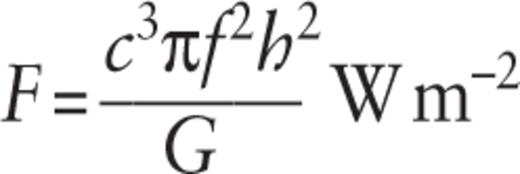
In fact we already know of specific examples: the orbital decays of several compact binary pulsar systems are accurately consistent with the gradual bleeding away of energy and angular momentum by gravitational wave emission. For example, the relatively sedate Hulse–Taylor binary pulsar PSR B1913+16 (Hulse and Taylor 1975, Taylor and Weisberg 1982) is illuminating the Earth with a strain amplitude of about 10-23, albeit at a frequency of around ~72 μHz, too low for ground-based instruments to detect. The closer and more compact double pulsar system J0737–3039 generates a strain of ~10-21 at 0.23 mHz and may itself be one of the many thousands of compact binary systems detectable by the space-based LISA observatory. As the orbit of J0737–3039 decays, and the two pulsars approach each other, the gravitational luminosity will increase as the inverse fifth power of the orbital radius to give a powerful “chirp” signal before the components collide. Although this particular system is not expected to merge for another 85 million years, the current LIGO observatories could detect such a chirp from the last few moments of a typical binary neutron-star system closer than 15 Mpc, and population studies indicate that the chances of an imminent detection are far from negligible.
At lower signal frequencies, a given strain sensitivity corresponds to a quadratically lower flux sensitivity, but the noisy gravitational environment on Earth makes it impossible to construct a sensitive detector here. Instead we must move to space, where the proposed gravitational wave observatory LISA will have a strain sensitivity of 10-23 in 1 year at a frequency of a few millihertz. In contrast to the above, this strain corresponds to a limiting magnitude of +18, similar to one's eye using a 1 m telescope at a dark site. Whereas the current generation of ground-based observatories are limited to the brightest sources, LISA will give us a deep view of the sky.
The technology
Although we will concentrate on the astrophysics, none of this can be possible without the current and next generation of gravitational wave observatories. The most sensitive instruments currently operating are variations on the theme of classical Michelson interferometry (figure 2). A light beam is split to shine down two kilometre-scale arms at right-angles to one another. The beams are bounced off one or more mirrors and returned to their point of departure, where they are superposed. Any slight differential variation in the lengths of the arms, as would be caused by the passage of a gravitational wave, varies the intensity of this superposition signal. The apparatus is kept in a one-dimensional free-fall by suspending the optical elements from pendulums. These pendulums have natural frequencies well below the sensitivity band of the telescope and act as filters, isolating the optics from any mechanical vibrations that would cause spurious signals. Because astrophysical gravitational waves have very long wavelengths in comparison to the dimensions of the instrument, the interferometer acts like a short antenna, akin to a hertzian dipole in electromagnetism. However, gravitational waves are naturally quadrupolar (there is no “opposite charge” with which to form a dipole), and the interferometer has a quadrupolar antenna pattern with nulls in directions from which an incoming plane wave would cause no differential arm movement. Just as in radio astronomy, data from these antennae can be combined to form phased arrays and, in principle, aperture synthesis instruments capable of measuring the spatial coherence of stochastic gravitational wave signals and generating images of the sky. Current observing programmes operate in the 50–1000 Hz gravitational waveband, so the Earth is 1 to 20 wavelengths in radius. High angular resolution is therefore impossible with terrestrial baselines, but a reasonably bright source may be positioned to within a few degrees using intercontinental antennas. In principle, for non-stochastic, long-lived sources such as mountainous, rapidly spinning, neutron stars, we can use the aperture synthesized by the Earth's orbit for astrometry to sub-arcsecond resolution.
The interferometer design used in LIGO. The light in each arm bounces back and forth many times between the test masses before returning to the beam splitter, where it is added to the light from the other arm. The resulting intensity, which is dependent on the differential path length travelled by the two beams, is measured at the photodetector.
In November 2005 the LIGO Scientific Collaboration (LSC) began its first long-duration, high-sensitivity observing run, with the explicit hope of a first direct detection of gravitational radiation. Currently the collaboration has access to four interferometers, and three of these comprise the US LIGO project. Two are located in the Hanford Nuclear Site in Washington State, both occupying the same beam tube, and the other is in Livingston, east of Baton Rouge, Louisiana. These are imposing structures (see figures 3 and 4), and the 4 km long arms that form the L-shaped interferometer are clearly visible from the air (enter 46.45,–119.4 and 30.55,–90.79 into Google Maps to see them). The fourth interferometer comes from the UK–German GEO collaboration and is located south of Hannover (52.25,9.81). Though shorter, and therefore less sensitive, than the US interferometers, GEO uses advanced suspension and material technologies to win back some of this sensitivity. These techniques will be central to Advanced LIGO, the upgrade of the LIGO interferometers due to be completed in 2013. Advanced LIGO will have more than 10 times the sensitivity of the current detectors and, for the reasons outlined above, will reach 1000 times the volume of space.
The LIGO Observatory on the Hanford Site, Washington state. Each arm is 4 km long. (LIGO)
A view up one arm of the LIGO Livingston interferometer. The 4 km concrete tunnel contains a 1.2 m diameter beam tube. At ~10-9 Pa, these are the largest high-vacuum systems ever built.
In addition to the LIGO and GEO interferometers, the French–Italian Virgo collaboration is currently commissioning a 3 km-arm interferometer in Cascina, south-east of Pisa (43.64,10.50). Virgo has an advanced passive seismic isolation system that promises to greatly enhance its low-frequency performance. The future for ground-based astronomy is dependent on a series of planned sensitivity improvements, through Virgo+ to Advanced Virgo, and through Enhanced LIGO to Advanced LIGO. Further groups have plans for advanced detectors, including the ICRR Tokyo (responsible for the earlier TAMA300 interferometer) and the Australian ACIGA consortium.
LISA (Laser Interferometer Space Antenna) represents a long-awaited move to space-based gravitational astronomy. With an anticipated launch date of 2015, LISA will operate in an environment free from the low-frequency noise sources present on Earth and will be able to see the universe in a band (~0.1 mHz to ~1 Hz) corresponding to the orbital periods of several important classes of binary compact objects. Although also a strain detector, LISA is not a conventional Michelson interferometer. Instead, it comprises three spacecraft forming an equilateral triangle of side 5 million km in an Earth-following orbit around the Sun (figure 5). Reference laser signals are exchanged in both directions along each side of the notional triangle, and the beats between these are counted to infer changes in the arm lengths due to the passage of gravitational waves through the instrument. Each signal is phase-referenced to a freely floating mass contained within each spacecraft, where it is protected against solar radiation pressure, the buffeting of the interplanetary environment and, by design, everything but gravity. LISA's band is broad, covering nearly four decades in frequency, and should see thousands of sources, but for the longer wavelengths of several AU, this instrument will have rather little angular resolution. At its shortest wavelengths, however, LISA will be able to pinpoint strong long-lived sources to within a few arcminutes.
LISA detects low-frequency gravitational waves using lasers to pick up changes in the separations of three spacecraft flying in an equilateral triangle of side 5 million kilometres. (ESA)
Ground-based astronomy
In common with electromagnetic astronomy, there are both advantages and disadvantages in having a ground-based gravitational observatory. On the plus side, being on the ground allows one to develop sophisticated instrumentation and spend money on the telescope rather than launch and support infrastructure necessary for space-based astronomy. As a bonus the Earth is transparent to gravitational radiation, so one classical disadvantage of ground-based work is removed. However, seismic noise and near-field gravitational noise sources make work difficult at frequencies below a few tens of hertz. The next generation of advanced detectors will push hard on this low-frequency limit, but the terrestrial gravitational window is naturally limited. There should, however, be several classes of highly luminous sources in view from the ground that promise to deliver high-quality astrophysics, and we will now consider two of these.
As we have seen, a sufficiently compact binary system comprising a neutron star (NS)/black hole (BH), NS/NS or stellar-mass BH/BH pairing will become increasingly luminous as the orbit decays and the resulting gravitational chirp will sweep through the passband of ground-based detectors (figure 6). This final chirp contains detailed information about the final ~100 to 1000 orbits of the system, which rapidly become more circular, including the precise orbital geometry from the phase and polarization of the wave, and the “chirp mass” of the system,
The inspiral phase of a compact binary system. The strength and frequency of the gravitational wave signal increases rapidly towards the end of this phase. (NASA/Dana Berry, Sky Works Digital)

from the rate of change of frequency. As we will see when we consider below the view from space, a strongly chirping NS/NS binary decaying due to gravitational radiation alone is a standard candle: its distance can be determined directly from its waveform because luminosity, as a function of frequency, also depends only on chirp mass. For NS/BH systems, we should see the tidal disruption of the NS during its final orbits, revealing its internal structure and equation of state.
These events are fascinating, but will we see one from the ground? The Hulse–Taylor system is 300 million years away from coalescence, and no known system will coalesce in the next 85 million years. In fact, we only know of perhaps eight NS/NS systems in total, from radio pulsar observations! Taking into account the selection effects that lead to these observations, we can say with some confidence that, at current sensitivities, ground-based detectors should not see more than 0.3 NS/NS inspirals per year. However, with their increased reach, advanced detectors can be expected to find between 10 and 500 per year (Kalogera et al. 2004). In contrast, the event rate for stellar-mass BH/BH and BH/NS binary mergers is unknown, so advanced detectors promise our first sightings and population studies of these. The final luminosity of binary black-hole coalescence is ~c5/G, or 1052 W, momentarily outshining the entire stellar population of the observable universe. Interestingly, this is independent of mass, though its duration is not.
The LIGO Scientific Collaboration is monitoring the local universe for a range of cataclysmic activity, including BH/BH mergers, NS/NS mergers, GRB coincidences, and unidentified bursts (Abbott et al. 2006, 2005a–c). There is a fighting chance of getting the first detection in the next year, but we are still some way from the culmination of the LIGO project, Advanced LIGO, for which such observations should be routine.
Continuous sources
Whereas cataclysmic sources are visible because they are spectacularly luminous, less luminous sources may be detected from the ground because they originate nearby. As angular momentum is radiated away gravitationally, any otherwise isolated physical system with a mass quadrupole moment can be expected to spin down, but for these close sources the spin down need be only very small for them to be seen. At the lower frequencies accessible from space, these sources can be ultra-compact white-dwarf binaries described below. From the ground, however, we are limited to rotation rates more characteristic of the spinning neutron stars in radio pulsars than the orbits of binary stars. Although any departure from axial symmetry in a spinning neutron star will result in gravitational radiation, and despite having a fair idea of the neutron-star population in the galaxy, we have little idea how smooth they are and therefore whether any will be visible with the current generation of detectors. We can, however, make a fair guess at how mountainous they are: the spin-down rates of pulsars (radio or X-ray-loud spinning neutron stars) are easily observed. The spin down must be at least partially due to magnetic dipole braking, as pulsars are highly magnetized objects, but if we allocate all the spin down we see to gravitational radiation, we can – with some assumptions – place an upper limit on the likely mass quadrupole of each pulsar. Doing this, it seems unlikely that more than two or three known radio pulsars could be seen right now, though more extensive searches are continuing (Abbott et al. 2005d). The most likely candidate is the Crab pulsar, whose spin-down limit promises to be well and truly broken with current observational sensitivities. A detection right now would still require the neutron star in the Crab to be distorted to an extent that could only be supported by strange matter (Owen 2005). Searches for gravitational waves from radio-quiet neutron stars are more difficult and represent a massive computational challenge. This has been met in part by the Einstein@Home project, a BOINC-based screensaver actively running on around 100 000 computers worldwide and delivering about 80 teraflops of processing power (see ).
Here we have just touched on the ongoing ground-based effort to detect gravitational radiation and to lay the foundations of gravitational astronomy. We have said nothing about the search for stochastic gravitational waves (statistically similar to electromagnetic signals, see for example Abbott et al. 2005e) and, by definition, nothing about serendipitous discoveries that any right-thinking astronomer hopes will come from a new way to look at the universe. Our view from the ground will always be limited, though, and we must go to space to get a fuller picture.
The view from space
Gravitational wave astronomy is set to take a huge leap forward towards the end of next decade, with the launch of the long-anticipated LISA mission. With its high sensitivity across a broad band of low-frequency gravitational radiation, LISA will detect and characterize tens of thousands of sources. LISA observations will have a dramatic impact on many diverse areas of astrophysics, from testing fundamental aspects of general relativity, through constraining models of stellar and galactic evolution to probing possible relics from the very early universe.
Figure 7 shows a comparison of the strain sensitivities predicted for LISA and Advanced LIGO. We see that the LISA band contains several different classes of compact binary system that are undetectable from the ground, of which the most important is massive black-hole binary systems. While some of these sources observed by LISA will be detectable only in gravitational waves, in most cases LISA will complement and significantly enhance the information that can be gleaned from electromagnetic observations of the sources. This multi-messenger approach will be a hallmark of several complementary projects planned for the next 10 to 20 years including, for example, the Square Kilometre Array radio telescope, the GAIA astrometry mission and the James Webb Space Telescope. There is insufficient space here for a comprehensive description of all areas of proposed LISA astrophysics. Instead we will briefly review three key topics: compact binary systems, black-hole astrophysics and precision cosmology. These topics sample the full spectrum of LISA applications and also illustrate some of the potentially huge benefits of multi-messenger astronomy that lie ahead.
Comparison of the predicted gravitational wave amplitude for several different classes of binary source that will be observable by LISA and Advanced LIGO. The red and blue curves show the predicted strain sensitivities of LISA and Advanced LIGO respectively. Note in particular that the coalescence of massive black-hole binaries, which will be among the brightest sources detected by LISA, will be essentially unobservable by Advanced LIGO.
Compact binary systems
The vast majority of the individual sources detected by LISA will be close binary systems consisting of two compact objects (white dwarfs, neutron stars or stellar-mass black holes) with an orbital period of a few minutes to a few hours, and therefore still some way from coalescence. Current estimates suggest that LISA will resolve tens of thousands of these sources, mainly with periods shorter than about 20 minutes. In marked contrast, fewer than 50 such sources are currently known from electromagnetic observations, and less than 10% of those systems have periods shorter than 20 minutes. It seems clear, therefore, that the impact of LISA observations of compact binary systems will be enormous, addressing key questions across a wide range of fields, from stellar evolution to galactic structure. One of the main reasons is that, for hundreds of binaries, LISA will provide high-precision measurements of the masses and distance of the compact objects in these systems. We can understand how this is possible as follows.
The frequency and phase evolution of the inspiral phase of a detached binary system is strongly dependent on the “chirp” mass. In this case the strain amplitude, h, frequency, f, and its time derivative, ḟ, measured at the solar system barycentre are related by where the constants of proportionality depend on (among other factors) the orientation and sky position of the binary. Thus, as was shown in a groundbreaking paper by Schutz (1986), measurement of h, f and ḟ permits precise determination of the chirp mass and distance of the source. The crucial factor here is the duration of the LISA observations: the longer the binary is observed for, the better determined is its evolution in frequency and its sky position and orientation, from the modulation of the source waveform due to the orbital motion of the LISA satellites.


We do not attempt to present a comprehensive survey of the astrophysical issues that LISA observations of compact binaries will address, but we can give a few illustrative highlights.
Verification binaries
Within its first few months of operation, LISA will observe and measure gravitational wave signals from a small number of compact binaries with great precision. These systems, known as verification binaries, already have accurate masses and distances from electromagnetic observations, so that their expected gravitational wave signals, and their uncertainties, can be predicted reliably (Stroeer and Vecchio 2006). Consequently the verification binaries will, in the first instance, offer a rigorous benchmark for LISA's performance and a calibration check for the measurement of binary parameters. More specifically, however, LISA observations of the two shortest period verification binaries, RX J0806.3+1527 and V407 Vul, with periods of 5.4 minutes and 9.5 minutes respectively, should settle the current astrophysical debate over their nature, indicating definitively whether the origin of the X-ray emission from these sources is due to, say, accretion or magnetic induction.
Stellar evolution and binary mass transfer
Detailed analysis of the frequency evolution in the gravitational wave signals from thousands of compact binary systems observed by LISA will shed light on several outstanding questions in binary stellar evolution. Although the orbital evolution of the compact binaries will mainly be driven by the loss of angular momentum due to gravitational wave emission, for very close binary systems tidal interactions and mass transfer between the two components also play a crucial role. However, several key aspects of these phenomena are quite poorly understood. For example, model estimates of the strength of tidal interaction between two white dwarfs range over several orders of magnitude (Marsh et al. 2004), despite the fact that this mechanism is believed to be a dominant factor in determining whether mass transfer proceeds via direct impact onto the accreting white dwarf or via the build-up of an accretion disc around it. Comparison of the observed frequency evolution with that predicted for a detached system will constrain the strength of tidal interaction and permit models of the nature and stability of the mass transfer mechanism to be tested rigorously. A closely related issue concerns the so-called “common envelope phase” of stellar evolution, where it is believed that short-period compact binaries previously evolved through a stage where one compact object found itself inside the outer layers of its giant companion. This phenomenon is also thought to have featured at least once in the evolution of X-ray binaries, binary pulsars and possibly short-period gamma-ray bursters. LISA measurements of the parameters of thousands of compact binaries that have (presumably) passed through the common envelope phase will allow models predicting its outcome to be tested directly for the first time. This will significantly enhance our understanding of the later stages of binary evolution, as well as more general aspects of the stellar evolution that precedes it.
Mapping the Milky Way
The precise distance determinations to hundreds of compact binaries that will be made possible with LISA will permit detailed mapping of the structure of the Milky Way galaxy. These will complement electromagnetic observations, particularly the high-precision parallax distance measurements expected from GAIA, because gravitational observations probe the otherwise inaccessible stellar distribution in the galactic centre and the galactic bar. This is due both to the intrinsic concentration of compact binaries in the galactic centre and the fact that their gravitational wave emission will be completely unaffected by the strong extinction that will severely limit the effectiveness of GAIA in the galactic plane. In addition to resolved sources, LISA will detect a galactic background of many tens of thousands of unresolved compact binaries at frequencies below a few millihertz, the vast majority of which will be white dwarf binaries. Although the signals from these sources will at some level become confusion noise, even this contains a wealth of useful statistical information concerning the 3-D spatial number density and sky distribution of the white dwarfs. The galactic background can be constrained by studying how the noise level is modulated by the changing orientation of the LISA constellation as it orbits the Sun. Extracting this information will present a considerable computational challenge for LISA data analysis, but together with an accurate 3-D map of the distribution of the resolved sources in the galaxy, it should yield a dramatically improved picture of the distribution of binaries in the halo, bulge and thick and thin disc, and hence of the role played by each of these components in the evolution of the Milky Way. Furthermore, while individual compact binaries will not be resolvable in external galaxies beyond the Magellanic Clouds, an extragalactic background “noise”, dominated by sources in galaxies at z~ 1, should be just about detectable by LISA, providing useful statistical constraints on cosmic star-formation history complementary to those from electromagnetic observations.
Black hole astrophysics
The number of stellar-mass binary black-hole systems in our galaxy is uncertain – indeed, there may be none. If such systems do exist, their interactions will be easily detected by LISA if they fall within its band. Even stronger sources, however, will result from massive black hole (MBH) interactions, either through their capture of stellar-mass compact objects in events known as “extreme mass ratio inspirals”, or through the violent merger of a binary MBH system. In the LISA frequency band the strongest sources of all will be MBH binaries, of 104 to 107 solar masses, in the cores of merging galaxies. These observations will complement the detections of intermediate mass (i.e. 100–1000 solar masses) black-hole mergers that can be expected in significant numbers from the next generation of ground-based detectors. Although the total number of MBH events likely to be observed by LISA is also uncertain, a large fraction of those detected will be present throughout LISA's period of operation: firstly for many months during the inspiral phase, when the signal-to-noise ratio slowly increases to reach into the hundreds or thousands just prior to merger. LISA will then also observe the “ringdown” phase, as (according to general relativity) the merged object relaxes to become a single, spinning Kerr black hole. MBH mergers will be so strong that they should be detectable by LISA to very high redshift. Indeed, their detection limit is essentially set not by their gravitational wave amplitude but by the distribution in redshift of when they formed, a function which is an important ingredient of current theories of hierarchical galaxy formation.
Hence, LISA observations will be a powerful probe of both the fundamental (and fairly clean) physics of general relativity, and the more complex (and considerably messier) physics of galaxy formation. We now briefly consider each of these applications in a little more detail.
Testing general relativity
One of the most fundamental physical issues that LISA observations will directly confront concerns the very nature of black holes themselves. In general relativity the “no hair” theorem states that all black-hole solutions – including the Kerr solution for an isolated, rotating black hole – can be completely described by only three parameters: mass, angular momentum and electrical charge. For LISA observations, only the first two parameters are relevant. More specifically, all information about the past history of the black hole, such as its environment and the type of matter from which it formed, is inaccessible to external observers once that matter has crossed its event horizon. Comparison of the observed ringdown waveform for MBH merger events with the predicted waveform for a Kerr black hole will give the first definitive verification that the Kerr metric is the correct GR description of the spacetime outside a rotating black hole, and that the no hair theorem is satisfied.
LISA observations of extreme mass ratio inspirals (EMRIs: the interaction of a massive black hole and a stellar-mass compact object) as they are captured and spiral inwards towards the MBH event horizon, are also expected to provide a strong test of the Kerr metric. During its inspiral phase each EMRI is likely to be detected for many thousands of wave cycles, and these gravitational waves will trace out in great detail the metric of the spacetime exterior to the MBH. Thus, in principle, one could use EMRI observations to reconstruct the spacetime metric without assuming a priori that it takes the Kerr form. Although the predicted waveforms of EMRIs are extremely complex (see figure 8), recently Glampedakis and Babak (2006) have developed a formalism for computing approximate – or “kludge”– EMRI waveforms, both for a pure Kerr and a perturbed “quasi-Kerr” metric. The authors find that a small deviation from a pure Kerr metric is sufficient to produce significant mismatch between the kludge waveforms for the unperturbed and perturbed cases – at least provided that the orbital parameters of the EMRI are known. While this method of “spacetime mapping” with EMRIs presents considerable computational and data analysis challenges (and indeed highlights a potential “source confusion” problem if Kerr waveform templates were used to study an EMRI encounter with a non-Kerr black hole, and vice versa) it nonetheless offers an exciting new avenue for testing the fundamental validity of the Kerr solution.
Characteristic waveforms for an extreme mass ratio inspiral (EMRI): the interaction of a massive black hole and a stellar-mass compact object. Although EMRI waveforms are complex, they can in principle be used to map in exquisite detail the spacetime exterior to a Kerr black hole, and indeed to test if the Kerr metric is valid. (From Drasco and Hughes [2006])
Probing galaxy formation
In the standard concordance cosmology, galaxies form via a hierarchical series of mergers of cold dark matter halos. Although very little is known observationally about the early stages of this process, the merger history of galaxies can be modelled in detail with high-resolution cosmological simulations; these suggest that galaxies like the Milky Way result from the merger of more than 1000 “proto-galaxies” which began forming at z > 20. It is possible that these proto-galaxies contained black hole “seeds” that themselves would have already begun to merge at high redshift, around z= 15 (Koushiappas et al. 2004). If these seeds were sufficiently massive (about 104 solar masses or more) then their mergers will produce gravitational waves that will be easily detectable by LISA, even at z~ 15. Hence LISA offers a unique opportunity to trace out the formation, growth and mergers of massive black holes over the entire history of galaxy formation, providing a crucial test of the predictions of cosmological simulations.
How many MBH mergers will LISA observe? The expected total event rate and redshift distribution of MBH mergers is uncertain, and indeed the measurement of these quantities will be one of the most important contributions made by LISA. (Note that the redshift of the MBH merger is not directly measurable from its gravitational waveform, but may be inferred from its measured distance assuming a cosmological world model. See Hughes [2002] for further details.) Another approach to determining the redshift is to identify an electromagnetic counterpart of the merger event; this approach is discussed further below. The observed rate will depend on the fraction of proto-galaxies that contain seed black holes massive enough to be detectable by LISA, and the fraction of those seed black holes that merge when their host proto-galaxies merge. Although neither fraction is currently well constrained from electromagnetic observations, fairly robust upper and lower bounds on the expected rate can be derived from our current understanding of hierarchical galaxy formation. These indicate that LISA should observe a merger rate in the range 1 to 1000 yr-1. The masses and redshifts of these MBHs will provide strong constraints on hierarchical galaxy formation models; their measured spins will provide valuable clues to the formation and growth mechanisms of the seed black holes from which they are built.
The potential impact of LISA observations of MBH mergers does not stop with galaxy formation. These observations could also be of enormous importance for calibrating the extragalactic distance scale and measuring the expansion rate of the universe. LISA will open a completely new window on the distance scale through the use of merging MBHs as high-precision distance indicators that will be a powerful adjoint to the traditional “standard candles”, such as Cepheid variables and Type Ia supernovae, that currently comprise the rungs of the cosmic distance ladder. Indeed, these distance indicators, applied on cosmological scales, have recently been given a new label: “standard sirens”. This cosmological application merits detailed discussion in its own right and we describe it in the next section.
Cosmology with standard sirens
The essence of the use of standard sirens as cosmological distance indicators is simple. As we noted previously in relation to galactic binary compact objects, the amplitude and shape of the gravitational waveform emitted by a MBH merger during its inspiral phase is strongly dependent on the chirp mass of the binary system. Since the amplitude also falls off inversely with distance, measurement of the waveform at the solar system barycentre allows, in principle, the luminosity distance of the binary also to be estimated precisely (Schutz 1986). Note, however, that the gravitational radiation from the MBH merger will be redshifted by the expansion of the universe in exactly the same way as electromagnetic radiation. This introduces a mass–redshift degeneracy: analysis of the waveform in fact only constrains the product of the mass parameters and the factor (1 +z), where z is the redshift of the source. So a key element in the use of standard sirens will be the identification of an electromagnetic counterpart of the MBH binary source: the redshift of the source can be determined from the electromagnetic spectrum, and the mass–redshift degeneracy broken.
The cosmological potential of standard sirens was first explored in detail in Holz and Hughes (2005), who also considered the question of identifying the electromagnetic counterpart given the typical LISA “error box” on the source sky location. Holz and Hughes concluded that typical distance uncertainties would be about 1% for an MBH at z~ 1, at least an order of magnitude better than the performance of (for example) Type Ia supernovae. They also concluded that the identification of a unique electromagnetic counterpart (likely to be a quasar radiating close to the Eddington luminosity) was feasible at this redshift – a conclusion supported, in a somewhat more thorough treatment of the counterpart issue, by Kocsis et al. (2006). In an important recent development Lang and Hughes (2006), following pioneering work by Vecchio (2004), extended the Holz and Hughes analysis to include the precession of an MBH binary induced by the spins of the black holes. This effect modulates the waveform, adding periodic structure that is strongly correlated with the other parameters of the binary, and its inclusion greatly improves the accuracy with which those parameters can be inferred: measurements of the binary masses are improved by one to several orders of magnitude and the uncertainty in the sky location of the binary is also dramatically reduced (which in turn greatly enhances the prospects of identifying an electromagnetic counterpart, in order to measure the redshift of the siren). Including precession, therefore, reduces the measurement uncertainty on the luminosity distance by a factor of 2 or 3, to about 0.2–0.4% at z~ 1.
There is an important caveat, however. Just like electromagnetic radiation, gravitational radiation will be subject to weak gravitational lensing by intervening matter. Hence, the amplitude of a MBH binary waveform will be magnified or de-magnified by the presence of large-scale structure along the line of sight towards the source. A failure to account for this effect would cause a systematic error in the estimated luminosity distance of each source. Of course, if a sufficiently large number of standard sirens were observed during the lifetime of the LISA mission, the impact of lensing would be alleviated simply through averaging. The expected total event rate and redshift distribution of MBH mergers is uncertain and, as we have seen in the previous section, is itself one of the main cosmological issues about which it is expected LISA will provide dramatic new insights. If the actual number of sirens detected by LISA were to lie at the high end of the expected range then the impact of lensing would be considerably reduced. Moreover, as recently pointed out by Dalal et al. (2006), weak lensing will be relatively unimportant for standard siren observations at z < 1. Those authors comment that even a single MBH standard siren observed at z < 0.5 could measure the Hubble parameter to better than 1%, a huge improvement over any other conventional distance scale method. Combining this H0 calibration with CMBR measurements of the density parameter and the absolute distance to the last scattering surface could then constrain the equation of state parameter w to better than 10%. In addition, Dalal et al. point out that merging neutron star binary standard sirens may be detectable from the next generation of networks of ground-based detectors, and these observations could also place competitive constraints on H0 and w. Figure 9, from Dalal et al. (2006), considers simulated LISA observations of 100 sirens, distributed with constant comoving space density in the range 0 < z < 2. The sirens constrain w and the dimensionless matter density at a precision comparable to 3000 Type Ia supernovae observed over a similar redshift range, a dataset typical of that anticipated from ambitious future supernova missions. Moreover, as the likelihood contours are almost orthogonal, the combined precision of supernovae and sirens is much better than either method alone.
LISA constraints on the matter density Ωm and dark energy parameter w. The solid contours show the 68% and 95% confidence regions expected for a sample of 100 standard sirens uniformly distributed between 0 < z < 2, while the dotted contours are for a sample of 3000 Type Ia supernovae over a similar redshift range. The dark shaded region shows the 68% confidence region for the combined constraints from both sirens and supernovae. (From Dalal et al. [2006])
In summary, therefore, MBH standard sirens have enormous potential as cosmological distance indicators, offering several unique advantages over other, more traditional, methods. First, they are essentially rather simple systems in that their precise waveform can be fully described by a small number of parameters involving physics that is much less complex than that which describes, for example, the light curves and spectra of Type Ia supernovae. Moreover their calibration makes no assumptions about their orientation or environment, and requires no corrections for extinction or evolution. Most importantly, their calibration is not an empirical one; an absolute theoretical calibration is provided by general relativity itself. Hence, in addition to providing a direct distance scale calibration of unprecedented precision in their own right, they will provide a crucial check of the systematic errors inherent in, for example, Type Ia supernovae distances (derived from combining multiple rungs of the traditional distance ladder). Furthermore, together with CMBR observations, distance measurements for even a handful of nearby sirens will provide constraints on dark energy comparable to those from much larger proposed supernovae and weak lensing surveys.
Concluding remarks
Although gravitational waves have yet to be detected directly, the evidence for their reality is overwhelming (not least from the binary pulsar observations mentioned above) and detector technology has finally reached the point at which there is a reasonable probability of a first detection. We can therefore say with some confidence that a profoundly new way of looking at the universe is within reach. In some ways we are at a similar point in gravitational astronomy to Galileo when he first pointed a crude electromagnetic telescope at the sky. With a similarly clear path of technological development to his, in our case from ground- to space-based detectors, we can all look forward to the full benefits of a truly new perspective on the universe.
Martin Hendry and Graham Woan survey the astrophysical problems that may be illuminated by the detection of gravitational waves – and how planned instruments will do so.



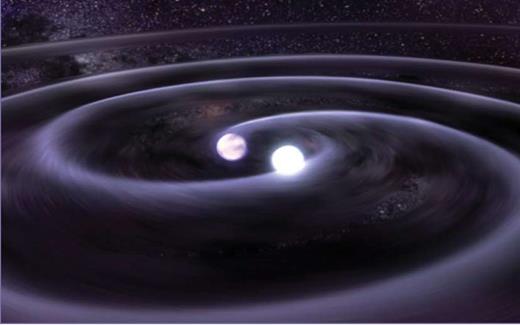
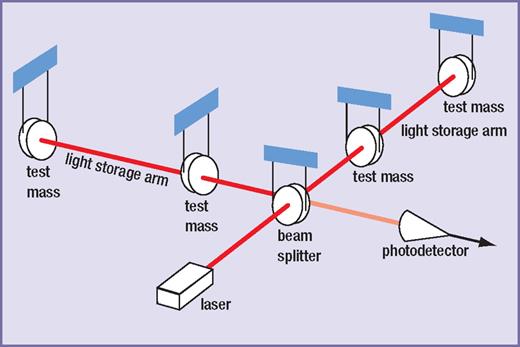
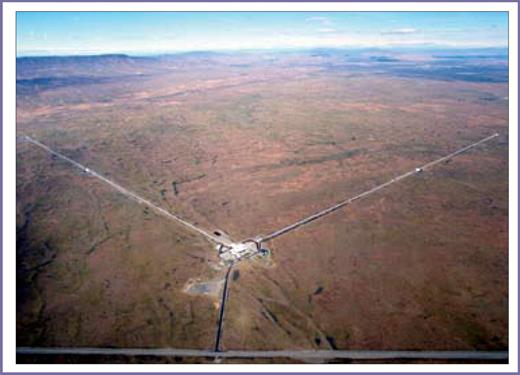

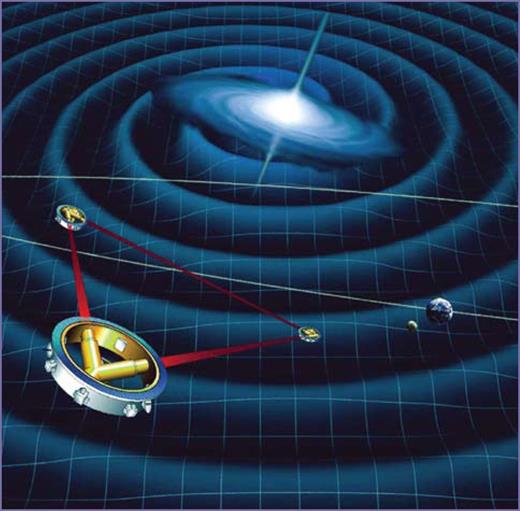
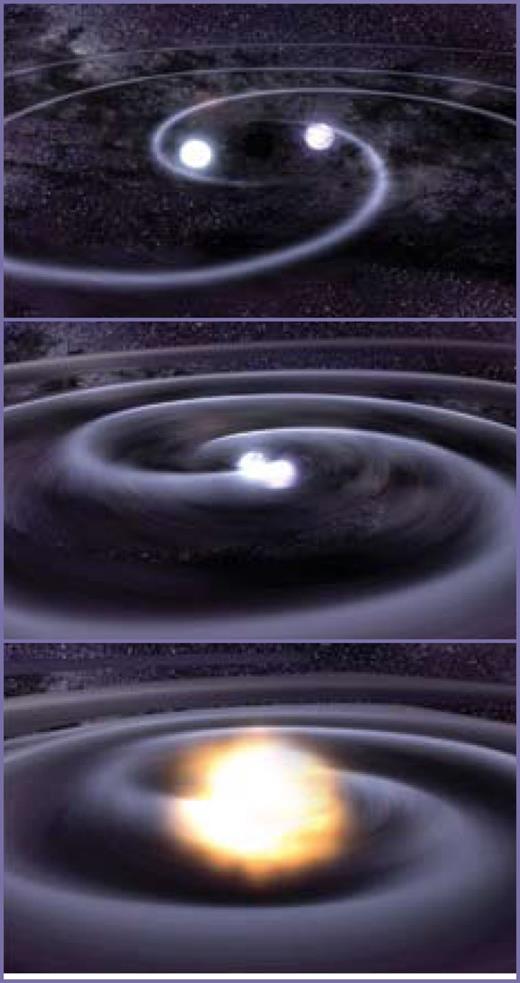
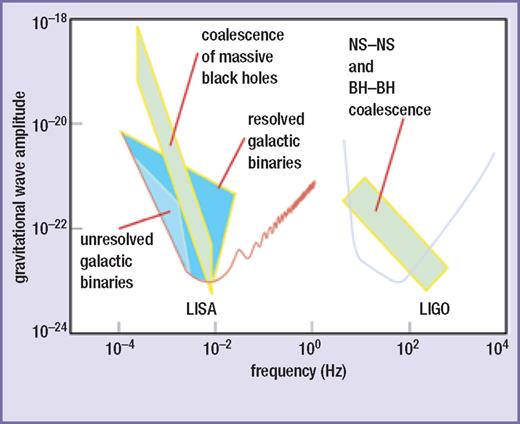
![Characteristic waveforms for an extreme mass ratio inspiral (EMRI): the interaction of a massive black hole and a stellar-mass compact object. Although EMRI waveforms are complex, they can in principle be used to map in exquisite detail the spacetime exterior to a Kerr black hole, and indeed to test if the Kerr metric is valid. (From Drasco and Hughes [2006])](https://oup.silverchair-cdn.com/oup/backfile/Content_public/Journal/astrogeo/48/1/10.1111/j.1468-4004.2007.48110.x/2/m_48-1-1.10-fig008.jpeg?Expires=1716329121&Signature=TKrL1BKWzt46bRlsPbTO5wZuaekk~UtMyYODcpjuHZxx2SDUKkGwuKkIapkFPqTGSk7rlQQPQ0FH3DiG1Ran7fhF~xCLcIdD-UIL2LUrhbfkQua0yb8rB7Qvt97g70ev4Kb1oGsUxcE~vIIF20iOcJPZHBgLRK09WhFQHdvRExGcIeFN7CeAGNMVfAwvJJ~oto4vr8pHp3KyBz4ysuLa1V-aLApywA3qdg~xzvQyUr~xoBW-96XitlEETd2yJkAMwbNbTCF5QDw8GvlEJRPT2YXnq~2lfvND3SG972mhvrI4kvshoE2yBWFhwjE6tycsbBepk~Cl3vQVY5dsy3fs1A__&Key-Pair-Id=APKAIE5G5CRDK6RD3PGA)
![LISA constraints on the matter density Ωm and dark energy parameter w. The solid contours show the 68% and 95% confidence regions expected for a sample of 100 standard sirens uniformly distributed between 0 < z < 2, while the dotted contours are for a sample of 3000 Type Ia supernovae over a similar redshift range. The dark shaded region shows the 68% confidence region for the combined constraints from both sirens and supernovae. (From Dalal et al. [2006])](https://oup.silverchair-cdn.com/oup/backfile/Content_public/Journal/astrogeo/48/1/10.1111/j.1468-4004.2007.48110.x/2/m_48-1-1.10-fig009.jpeg?Expires=1716329121&Signature=SDlYJtjnAzGrxSeqoyKT5Ivd5NS82ZPGSYYbA99izu8iJbtwB7F5j5Pdgy8vNNBZjgKAAkCtK6RTKsKC79bFj2TctFCUpGPVjYkOKeFkyGDlksTuN3c55UF6qEgAUivCaWLdQpC2Akh3wxe4TZt5w-U-ypEAD7UHQGIyVIX-9zZarDyh9gW8XAAM9vT~52eAHEJQTJU0PDjrQdhUn37VM10tQbLYG9S66Mg06zcgmYRV~CwqkIDQ8fz8oltD32D7fYCV70ANWElgTL8OHT9~eOjW0HAhO6y8woLLRMBztTjiy-Gzx1BE7nLGXos3pQK-b7UdyEx2aAV5TegH~bqaLA__&Key-Pair-Id=APKAIE5G5CRDK6RD3PGA)
